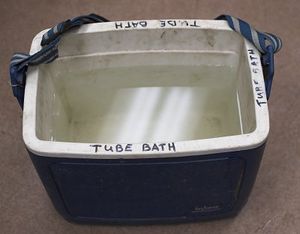To contribute to this wiki, please contact bikebikeeverywhere@gmail.com if you would like us to create you an account. The Contribute to this Wiki page goes into detail about how to make contributions and what information should be included.
Para contribuir a este wiki, por favor escribe a bikebikeeverywhere@gmail.com si deseas que creemos una cuenta para ti. La página Contribute to this Wiki explica en detalle cómo hacer contribuciones y qué información debe incluirse.
Checking Tubes
The co-op makes an effort not to waste all resources. This includes tubes that have holes but might be patchable. Sorting the tubes to determine which are good, which have patchable holes, and which are beyond help is a good volunteer task; it isn't very hard, and it helps volunteers be prepared for assessing the situation when they get a flat on the road.
Basic procedure
The first step in checking a tube is looking for obvious leaks. Start to inflate the tube. If it won't even hold enough air to take shape, the hole is huge and should be easy to find. If it holds air, completely detach the pump and listen around the tube for hissing. If you can't hear any hissing, you will need to dunk the tube into water and look for bubbles. Submerge part of the tube into the container, and rotate the tube slowly until every part of it has been under the water.
If you don't see any bubbles, the tube is good and you should put a rubber band around it so that it can be sold as a good used tube. If you haven't submerged the tube, you don't know that it is good. You should never put a rubber band around a tube that isn't wet at the time.
Tubes with leaks
In general, you'll put tubes with leaks in a pile to be patched. However, there are several exceptions:
- If the air is coming out of side of the valve stem, the tube is scrap. Valve stem cuts cannot be patched.
- If there is a huge hole from a blowout, the tube generally cannot be patched. If it's pretty big but you're not sure it's too big, put it in the patch pile and let the patcher decide.
- If the tube is leaking from the side of a patch, it is scrap. You can't patch over a patch, or replace one.
These are NOT reasons to scrap a tube:
- The tube already has a patch or two on it. This is fine, as long as the patches aren't leaking.
- The tube is leaking out of the end of the valve stem. This can be fixed.
- Two holes close together. This is likely a pinch flat caused by under-inflation. It is patchable.
- The tube takes on a weird shape when you inflate it, with one part bulging out or staying narrower. This is just inconsistent thickness, and is fine.
- Error creating thumbnail: File missing
Tube with a bulge




